Related Research Articles

Grappling, in hand-to-hand combat, is a sport that consists of gripping or seizing the opponent. Similarly to wrestling, grappling is used at close range to gain a physical advantage over an opponent such as imposing a position, or to cause injury to the opponent. Grappling covers techniques used in many disciplines, styles and martial arts that are practiced both as combat sports and for self-defense. Grappling contests often involve takedowns and ground control, and may end when a contestant concedes defeat, also known as a submission or tap out.
Martial arts are codified systems and traditions of combat practiced for a number of reasons such as self-defense; military and law enforcement applications; competition; physical, mental and spiritual development; and entertainment or the preservation of a nation's intangible cultural heritage.

Filipino martial arts (FMA) refer to ancient Indianized and newer fighting methods devised in the Philippines. It incorporates elements from both Western and Eastern Martial Arts, the most popular forms of which are known as Arnis, Eskrima, and Kali. The intrinsic need for self-preservation was the genesis of these systems. Throughout the ages, invaders and evolving local conflict imposed new dynamics for combat in the islands now making up the Philippines. The Filipino people developed battle skills as a direct result of an appreciation of their ever-changing circumstances. They learned often out of necessity how to prioritize, allocate and use common resources in combative situations. Filipinos have been heavily influenced by a phenomenon of cultural and linguistic mixture. Some of the specific mechanisms responsible for cultural and martial change extended from phenomena such as war, political and social systems, technology, trade and practicality.
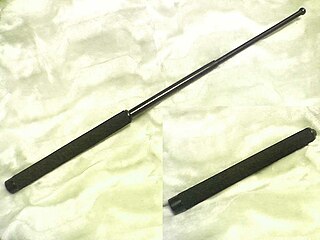
Self-defense is a countermeasure that involves defending the health and well-being of oneself from harm. The use of the right of self-defense as a legal justification for the use of force in times of danger is available in many jurisdictions.

Kalaripayattu also known simply as Kalari, is an Indian martial art and fighting style that originated in modern-day Kerala. Kalaripayattu is held in high regard by martial artists due to its long-standing history within Indian martial arts. It is believed to be the oldest surviving martial art in India. It is also considered to be among the oldest martial arts still in existence, with its origin in the martial arts timeline dating back to at least the 3rd century BCE.

Silambam is a weapon-based Indian martial art originating in modern-day Tamil Nadu in the Indian subcontinent and is estimated to have originated in approximately 1000 BCE, This ancient fighting style is mentioned in Tamil Sangam literature 400 BCE.

Japanese martial arts refer to the variety of martial arts native to the country of Japan. At least three Japanese terms are used interchangeably with the English phrase Japanese martial arts.

A strike is a directed physical attack with either a part of the human body or with an inanimate object intended to cause blunt trauma or penetrating trauma upon an opponent.
Swordsmanship or sword fighting refers to the skills of a swordsman, a person versed in the art of the sword. The term is modern, and as such was mainly used to refer to smallsword fencing, but by extension it can also be applied to any martial art involving the use of a sword. The formation of the English word "swordsman" is parallel to the Latin word gladiator, a term for the professional fighters who fought against each other and a variety of other foes for the entertainment of spectators in the Roman Empire. The word gladiator itself comes from the Latin word gladius, meaning "sword".
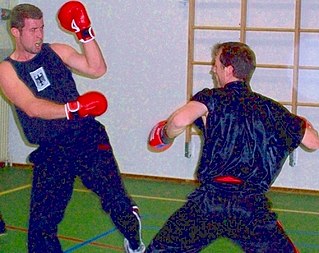
Sanda, formerly Sanshou, also known as Chinese boxing or Chinese kickboxing, is the official Chinese full contact combat sport. Sanda is a fighting system which was originally developed by the Chinese military based upon the study and practices of traditional Kung fu and modern combat fighting techniques; it combines full-contact kickboxing, which includes close range and rapid successive punches and kicks, with wrestling, takedowns, throws, sweeps, kick catches, and in some competitions, even elbow and knee strikes.

A combat sport, or fighting sport, is a competitive contact sport that usually involves one-on-one combat. In many combat sports, a contestant wins by scoring more points than the opponent or by disabling the opponent. Common combat sports include mixed martial arts, boxing, wrestling, judo, fencing, savate, kickboxing, Muay Thai, Sanda, Tae Kwon Do, Capoeira, Brazilian Jiu-jitsu, HMB, Sambo, Sumo, Kyokushin, and Kūdō.

The Marine Corps Martial Arts Program is a combat system developed by the United States Marine Corps to combine existing and new hand-to-hand and close quarters combat techniques with morale and team-building functions and instruction in the Warrior Ethos. The program, which began in 2001, trains Marines in unarmed combat, edged weapons, weapons of opportunity, and rifle and bayonet techniques. It also stresses mental and character development, including the responsible use of force, leadership, and teamwork.
Indian martial arts refers to the fighting systems of the Indian subcontinent. A variety of terms are used for the English phrases “Indian martial arts”, usually deriving from Dravidian sources. While they may seem to imply specific disciplines, by Classical times they were used generically for all fighting systems.
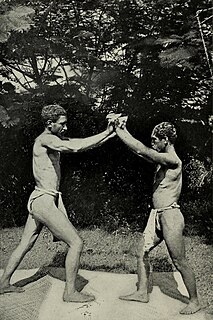
Kapu Kuʻialua; Kuʻialua; or Lua; is an ancient Hawaiian martial art based on bone breaking, joint locks, throws, pressure point manipulation, strikes, usage of various weapons, battlefield strategy, open ocean warfare as well as the usage of introduced firearms from the Europeans.
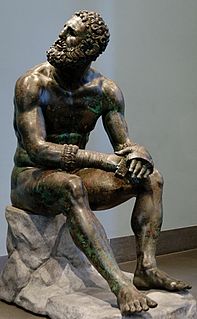
Although the earliest evidence of martial arts goes back millennia, the true roots are difficult to reconstruct. Inherent patterns of human aggression which inspire practice of mock combat and optimization of serious close combat as cultural universals are doubtlessly inherited from the pre-human stage and were made into an "art" from the earliest emergence of that concept. Indeed, many universals of martial art are fixed by the specifics of human physiology and not dependent on a specific tradition or era.
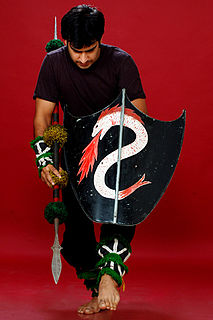
Huyen langlon is an Indian martial art from Manipur. In the Meitei language, huyen means war while langlon or langlong can mean net, knowledge or art. Huyen langlon consists of two main components: thang-ta and sarit sarak. The primary weapons of huyen langlon are the thang (sword) and ta (spear). The spear can be used in its non-missile form while in close or thrown from afar. Other weapons include the shield and the axe. Unarmed combat incorporates hand strikes, kicks, and grappling (mukna). Because of Manipur's cultural similarity and geographical proximity with Myanmar, huyen langlon is closely related to Burmese bando and banshay.

Combat Hapkido is an eclectic modern Hapkido system founded by John Pellegrini in 1990. Taking the next step in 1992 Pellegrini formed the International Combat Hapkido Federation (ICHF) as the official governing body of Combat Hapkido. Later, in 1999, the ICHF was recognized by the Korea Kido Association and the World Kido Federation, collectively known as the Kido Hae, as the Hapkido style Chon Tu Kwan Hapkido. The World Kido Federation is recognized by the Government of South Korea as an organization that serves as a link between the official Martial Arts governing body of Korea and the rest of the world Martial Arts community. The founder of Combat Hapkido was very clear in his statement that he did not invent a new martial art. He stated "I have merely structured a new Self-Defense system based upon sound scientific principles and modern concepts. For this reason Combat Hapkido is also referred to as the "Science of Self-Defense." Combat Hapkido is a new interpretation and application of a selected body of Hapkido techniques. The word "Combat" was added to Combat Hapkido to distinguish this system from Traditional Hapkido styles and to identify its focus as Self-Defense.

Jujutsu, also known as Jujitsu or Japanese Ju-Jitsu, is a family of Japanese martial arts and a method of close combat for defeating an opponent in which one uses either a short weapon or bare hands, and selected subset of techniques from certain styles of Japanese Jujutsu were used to develop modern combat sports, such as Judo, Sambo, ARB & Brazilian Jiu-Jitsu.
Italian martial arts is the use of weapons. Each weapon is the product of a specific historical era. The swords used in Italian martial arts range from the gladius of the Roman legionaries to swords which were developed during the renaissance, the baroque era and later. Short blades range from medieval daggers to the liccasapuni Sicilian duelling knife.
References
- 1 2 3 4 Prindle, Drew (Jul 5, 2014). "Leave it to Australians to resurrect gladiator duels with carbon-fiber suits". Digital Trends.
- 1 2 3 4 5 Blain, Loz. "Unified Weapons Master: Bloodless, high tech, full contact weapons fighting to debut in 2016". Giz Mag.
- 1 2 3 4 5 6 Healey, Nic (Jul 16, 2014). "Unified Weapons Master offers high-tech gladiatorial combat". CNet.
- 1 2 3 Gross, Doug (Mar 5, 2014). "Batman meets Iron Man in this high-tech armor". CNN.
- 1 2 3 4 Smith, Copper (Aug 27, 2015). "'Unified Weapon Master' on Indiegogo". Geek Smash.
- 1 2 3 Kate Pope, Devin (Sep 3, 2015). "Coming soon: Martial artists competing at full force in high-tech armor". TechSpot.
- 1 2 3 4 5 6 7 Cormack, Lucy (Jul 10, 2014). "The Lorica gladiator suit takes the pain out of armed combat". Sydney Morning Herald.
- 1 2 "Martial arts specialists raising funds for revolutionary new battle suit – a real life MORTAL KOMBAT". Yorkshire Evening Post. Sep 8, 2015.
- ↑ Simpson, Campbell (Feb 24, 2014). "Unified Weapons Master Combines MMA With Australian-Made High-Tech Armour And Deadly Weapons". GizModo.